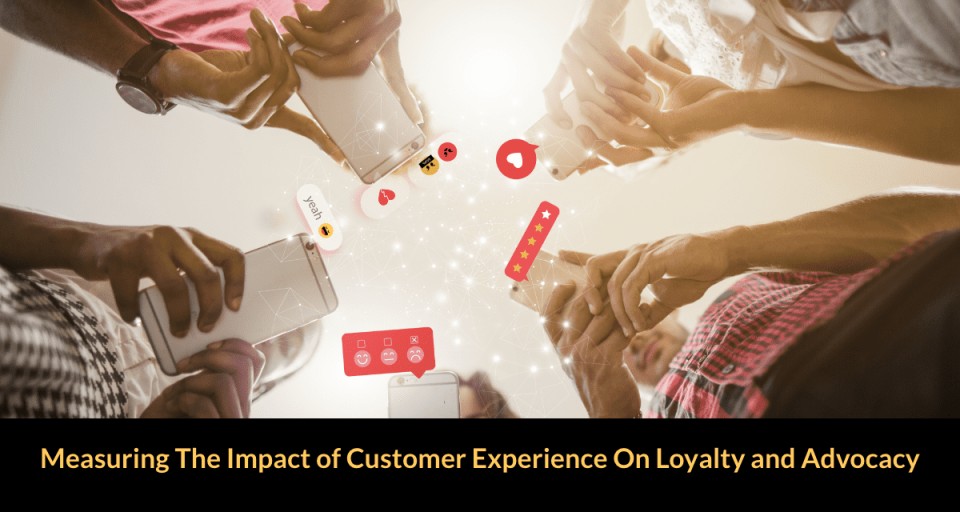The relationship between customer experience and customer loyalty is a critical driver of success. Evolving far beyond its traditional role of issue resolution, customer experience now plays a pivotal role in shaping the post-purchase customer experience across various industries. This evolution signifies a strategic transformation, positioning customer experience as a problem-solving tool and a key influencer in nurturing lasting customer relationships and bolstering brand advocacy.
This shift in perspective highlights the growing recognition of customer experience’s influence on sustaining and amplifying customer loyalty. It marks a transition from reactive service to proactive engagement, with each interaction offering an opportunity to strengthen the bonds of loyalty. Regardless of the industry context, the support quality can significantly impact how customers perceive and engage with a brand.
In this blog, we will go deeper into the transformative role of customer experience in building stronger customer loyalty. By exploring strategic approaches and practices, we aim to highlight how practical customer experience can transcend traditional functions, becoming a powerful force in fostering customer advocacy. Additionally, the narrative will shed light on sophisticated strategies that can be employed to nurture a loyalty-centric culture, thereby solidifying a brand’s reputation and advocacy in an ever-evolving competitive landscape.
From Solving Problems to Building Brand Advocacy
Transitioning from merely addressing issues to actively enhancing customer loyalty involves a strategic shift in customer experience. It’s about transforming every interaction into an opportunity for deepening customer relationships and building brand advocacy.
Strategies for Leveraging Customer Experience in Building Customer Loyalty
Transforming customer experience from a primary service function into a key brand loyalty and advocacy driver involves strategic and empathetic engagement, especially after negative experiences. Here, we refocus on crucial strategies that are instrumental in this transformation:
1. Active Listening and Empathy
2. Swift and Effective Solutions
3. Prompt and Transparent Communication
4. Follow-up and Feedback Collection
5. Surprise and Delight
6. Share Success Stories
7. Engage on Social Media
8. Cultivate a Culture of Customer Advocacy
1. Active Listening and Empathy
Active listening and empathy are at the heart of transforming negative customer experiences and increasing customer happiness. When support staff genuinely listen to and empathize with customers, they understand the problem better and make the customers feel heard and valued. This approach is crucial, especially in negative situations, as it can significantly shift the customer’s perception from frustration to trust and appreciation.
Train support staff to practice active listening, which involves attentively listening, acknowledging the customer’s feelings, and confirming their concerns. Empathy should go beyond words; it should be reflected in how solutions are offered and the overall approach to resolving the customer’s problem.
2. Swift and Effective Solutions
Rapid and efficient resolution of issues is key to preventing customer dissatisfaction. When customers face problems, the speed and effectiveness of the solution provided can make the difference between losing their trust and converting them into brand advocates. Implement systems that immediately respond to customer complaints or issues. Develop clear protocols for swiftly resolving common issues, ensuring the solutions effectively address customer concerns.
3. Prompt and Transparent Communication
Timely and transparent communication is crucial. Respond to customer concerns promptly, showing that their issues are a priority. Transparency involves being open about the steps being taken to address the problem. Keeping customers informed instills confidence and demonstrates a commitment to resolving the issue.
4. Follow-up and Feedback Collection
Post-resolution follow-up and feedback collection are critical in solidifying a positive customer experience and demonstrating that a brand values its customers’ opinions. Establish a process for following up with customers after resolving their issues, ensuring they are satisfied with the solution and their overall experience. Implement effective feedback mechanisms that allow customers to share their support experience easily. This information should be used to improve customer experience services continually.
5. Surprise and Delight
Surprise and Delight is a customer service strategy that exceeds expectations by offering unexpected and positive gestures. This approach is particularly powerful in resolving negative experiences turning setbacks into opportunities to showcase exceptional customer care.
The key lies in personalization, ensuring these surprises resonate with individual customers and contribute to building lasting impressions. Surprise and Delight fosters memorable customer experiences and cultivates brand loyalty and advocacy by evoking positive emotions.
6. Share Success Stories
With the customer’s permission, sharing success stories is a powerful way to showcase positive outcomes. Whether through testimonials, case studies, or social media posts, sharing how negative experiences were successfully resolved reinforces the brand’s commitment to customer satisfaction. It provides tangible examples of turning dissatisfaction into advocacy.
7. Engage on Social Media
Leveraging social media for loyalty and public engagement is vital. Addressing negative experiences openly and professionally on platforms like Twitter or Facebook resolves the issue for the concerned customer and demonstrates transparency to a broader audience. Social media engagement showcases the brand’s commitment to customer service in a visible and accessible way.
8. Cultivate a Culture of Customer Advocacy
Building a culture of customer advocacy involves instilling a mindset across the organization. It includes training employees to prioritize customer needs, encouraging collaboration between departments to ensure a cohesive customer experience, and fostering a proactive approach to turning negative situations into opportunities for building stronger customer relationships.
By integrating these strategies into customer experience operations, businesses can transform negative experiences into opportunities for building loyalty and advocacy. Active listening and empathy show customers they are valued, swift solutions address their concerns effectively, and follow-ups with feedback collection demonstrate a commitment to continual improvement and customer satisfaction. These approaches resolve immediate issues and foster long-term loyalty and advocacy for the brand.
The Transformative Power of Post-Purchase Support
Post-purchase support is a crucial stage in shaping customer advocacy. How support issues are handled can significantly influence a customer’s perception and willingness to advocate for the brand.
Best Practices in Post-Purchase Customer Experience
1. Prompt Follow-up After the Purchase
2. Provide Educational Content
3. Regular Check-Ins to Improve Experience
How Does Post-Purchase Experience Affect Brand Loyalty?
1. Transforming Experiences
2. Customer Retention and Advocacy
3. Innovative Support Solutions
4. Brand Reputation Enhancement

Best Practices in Post-Purchase Customer Experience
To ensure a positive impact on customer loyalty and satisfaction post-purchase, it’s essential to follow certain best practices:
1. Prompt Follow-up After the Purchase
Reach out to customers soon after purchase to thank them and offer additional support. This proactive approach demonstrates a commitment to customer satisfaction.
2. Provide Educational Content
Provide valuable information, such as guides or tutorials, to help customers make the most of their purchases. This enhances their experience and positions your brand as a helpful resource.
3. Regular Check-Ins to Improve Experience
Schedule periodic communications to stay in touch with customers, gather feedback, and offer assistance. This keeps the relationship active and shows that you value their ongoing business.
How Does Post-Purchase Experience Affect Brand Loyalty?
1. Transforming Experiences
Converting customer experiences from damaging to positive is crucial. Effective customer experience is about evolving every interaction into an opportunity to boost brand loyalty and reputation.
- Example scenario: Handling a customer’s issue effectively can change a one-time transaction into a lifelong advocacy.
- Rapid response: Quick, empathetic resolutions are vital. The effectiveness of the response can significantly alter customer perception.
2. Customer Retention and Advocacy
The approach to post-purchase support directly influences customer retention and advocacy. Satisfied customers often evolve into brand ambassadors, amplifying positive experiences within their networks.
3. Innovative Support Solutions
Integrating advanced support strategies enhances overall customer experience. For example, you can employ advanced CRM tools for personalized customer experience.
- Personalized communication: Tailor interactions to demonstrate value and understanding towards customers.
- Feedback mechanisms: Implement post-resolution feedback processes for continuous service improvement, showcasing a commitment to customer satisfaction.
4. Brand Reputation Enhancement
Effectively managed negative experiences can transform into compelling advocacy stories, bolstering brand reputation and enhancing customer loyalty.
Zinrelo’s Role in Enhancing Customer Experiences
The focus of customer loyalty programs has shifted significantly in the current customer engagement landscape. Beyond monetary rewards, these programs now emphasize creating value through personalized experiences and exclusivity-based milestones. This evolution is pivotal in cultivating long-term customer loyalty, as it aligns more closely with individual customer preferences and interests. By offering unique, experiential rewards, businesses can deepen their connection with customers, enhancing brand loyalty and fostering sustained engagement.
The effectiveness of these revamped loyalty programs is measured mainly by loyalty program metrics like the Net Promoter Score (NPS), which assesses the likelihood of customers recommending a brand to others. Technology integration is critical in this context, enabling businesses to tailor customer interactions based on detailed data analysis.
This approach ensures a seamless and intuitive customer experience, reducing friction in loyalty program participation and elevating overall satisfaction. Continuous improvement, driven by customer feedback, ensures these programs remain relevant, engaging, and effective in a rapidly evolving market.
Loyalty Program is Your Essential Customer Experience Tool
Learn how our holistic loyalty platform can transform your business.
Why Focus on Negative Customer Exp
eriences?
Effective customer experience is not just a service function; it’s a significant contributor to brand reputation. Every customer interaction with your support team can reinforce or diminish their trust in your brand. Here’s how excellent customer experience can enhance your brand’s reputation:
1. Creating Positive Word-of-Mouth
2. Turning Negative Experiences Around
3. Statistical Insights
4. The Ripple Effect of Customer Advocacy
1. Creating Positive Word-of-Mouth
Converting negative encounters into positive ones not only restores customer satisfaction but also has the potential to create vocal brand supporters. This organic advocacy, fueled by the turnaround of a negative situation, possesses a remarkable influence, often surpassing the impact of conventional marketing efforts.
2. Turning Negative Experiences Around
Proactively addressing and resolving issues can transform a potentially negative situation into a positive one, demonstrating your commitment to customer satisfaction. This responsiveness can significantly improve your brand’s image and credibility in the market.
3. Statistical Insights
The impact of customer experience on brand reputation is underscored by compelling statistics. According to Hubspot Research, 72% of consumers are willing to spend more with companies that offer good customer experiences. This highlights the direct correlation between customer satisfaction and increased revenue, emphasizing the critical role of customer experience in driving business growth and enhancing brand reputation.
4. The Ripple Effect of Customer Advocacy
Customers advocating for your brand based on their support experiences creates a ripple effect. Their endorsements, whether through social media or personal recommendations, amplify your brand’s reputation, attracting new customers and retaining existing ones.
Turning Negative Experiences into Brand Advocacy Opportunities: Examples
In our exploration of transforming negative customer experiences into positive brand advocacy, it’s enlightening to examine real-world examples where businesses have exemplified this transformation. Let’s delve into a few memorable instances:
1. Sainsbury’s and the Tiger Bread Story
A charming example of empathy and active listening comes from Sainsbury’s supermarket, highlighting their response to a young customer’s observation. When 3-year-old Lily Robinson wrote to Sainsbury’s questioning why ‘tiger bread’ wasn’t called ‘giraffe bread,’ the customer experience team saw an opportunity to engage delightfully and humanly. Their empathetic response and willingness to embrace Lily’s idea won her family over and captured customers’ hearts nationwide when the story went viral. Sainsbury’s eventually renamed the bread to ‘giraffe bread,’ showcasing a brand deeply in tune with its customers.
2. Gaylord Opryland’s Personalized Customer Experience
Consider the story of Christina McMenemy at the Gaylord Opryland Hotel, which underscores the importance of understanding and catering to repeat customers. McMenemy was enchanted by a unique alarm clock in her hotel room for three years but couldn’t find it for purchase. On reaching out to the hotel, Opryland went above and beyond by gifting her the clock. This thoughtful gesture ensured McMenemy’s loyalty and garnered positive attention when she shared her experience online, illustrating how personalization and thoughtful responses can lead to strong advocacy.
3. Bungie’s Heartwarming Gesture
Bungie’s response to a young fan unable to play their ‘Halo’ game due to a liver transplant surgery is a prime example of brand reputation management through compassion. Their gift of a card, custom helmet, and other items didn’t just make a child’s holiday brighter but significantly uplifted Bungie’s image in the gaming community.
4. Jim Shukys’ Auto’s Thoughtful Thank-You Note
Sometimes, it’s the small gestures that leave a lasting impression. A Jim Shukys’ Auto customer in Ohio shared a heartfelt thank-you note they received from the business online. This simple gratitude turned a routine service into an unforgettable experience, prompting even non-customers to praise the company online. It exemplifies how consistent, exceptional service can significantly enhance a business’s reputation and lead to customer advocacy.
These stories vividly demonstrate how businesses can turn ordinary interactions into extraordinary examples of customer advocacy by listening and responding with empathy, creativity, and personalization. They exemplify the essence of transforming challenges into opportunities to deepen customer relationships and bolster brand loyalty.
How to Measure the Impact of Customer Experience on Customer Loyalty
1. Key Metrics for Assessing Customer Experience Effectiveness
2. Analyzing Customer Feedback to Improve Support Strategies
3. Utilizing Analytics Tools for Monitoring and Enhancing Customer Loyalty

1. Key Metrics for Assessing Customer Experience Effectiveness
Key metrics such as the Net Promoter Score (NPS) are essential to gauge the effectiveness of customer experience. NPS measures the likelihood of customers recommending a brand to others, clearly indicating customer satisfaction and loyalty.
2. Analyzing Customer Feedback to Improve Support Strategies
Analyzing customer feedback is crucial in refining support strategies. By systematically gathering and examining feedback, businesses can identify areas for improvement and opportunities to enhance the customer experience. This feedback can range from direct comments on support interactions to broader opinions shared on social media and review platforms.
3. Utilizing Analytics Tools for Monitoring and Enhancing Customer Loyalty
Modern loyalty program data-analytics tools play a pivotal role in monitoring customer interactions and loyalty. By leveraging these tools, businesses can comprehensively understand their customer experience performance and its impact on customer loyalty. Tools from various platforms provide a wealth of data that can be used to tailor support strategies, ensuring they are as effective as possible in building and maintaining customer loyalty.
Leveraging Technology and Human Touch to Tackle Negative Experiences
1. Efficient Issue Resolution with Technology
2. Human Touch for Understanding and Empathy
3. Balancing Efficiency and Personalization
4. Enhancing Customer Connection
5. Adapting to Diverse Customer Needs
6. Continuous Improvement Through Feedback

1. Efficient Issue Resolution with Technology
In optimizing customer experiences, integrating technology is pivotal in expediting issue resolution. Automated systems and advanced tools are harnessed to swiftly address routine customer concerns, ensuring a seamless and efficient process. These technologies streamline customer service workflows, reducing response times and minimizing customer frustration. The implementation of automation not only enables businesses to address issues promptly but also provides 24/7 availability, ensuring that customer concerns are handled promptly, regardless of the time of day.
2. Human Touch for Understanding and Empathy
While technology provides efficiency, the human touch remains indispensable in comprehending the nuanced nature of customer issues. Trained human agents bring a level of understanding and empathy that goes beyond the transactional aspects of problem-solving. Their empathetic responses offer emotional support and assurance, acknowledging the unique circumstances and concerns of each customer. The personalization introduced through human interaction contributes significantly to a more positive and humanized customer experience, creating a connection that goes beyond the capabilities of technology alone.
3. Balancing Efficiency and Personalization
Achieving a balance between efficiency and personalization is a key aspect of an optimized customer experience strategy. Technology excels in handling repetitive and high-volume tasks, allowing human agents to focus on more complex issues that demand personalized attention. This collaborative approach ensures that efficiency is not compromised while still valuing the personal connection between the customer and the brand. By leveraging the strengths of both technology and human interaction, businesses can provide tailored solutions that meet individual customer needs.
4. Enhancing Customer Connection
The integration of technology and human touch contributes to a more profound customer connection. While technology supports consistent and standardized service, the human touch adds a personalized and relatable dimension. Human agents foster a sense of connection and loyalty through their interactions, creating an emotional resonance that goes beyond the transactional. This harmonized approach enhances overall customer satisfaction and trust in the brand, as customers feel not only efficiently served but also personally understood.
5. Adapting to Diverse Customer Needs
The synergy between technology and human interaction is particularly valuable in addressing diverse customer needs. Technology adapts to high-volume tasks, catering to the needs of a broad customer base with consistency and accuracy. On the other hand, human agents excel in handling unique and diverse customer situations, ensuring adaptability to individual preferences and concerns. This collaborative approach allows businesses to cater to the varied demands of their customer base, creating a more inclusive and customer-centric service model.
6. Continuous Improvement Through Feedback
Both technology and human touch contribute to a feedback-driven improvement process. Technology is employed to gather data and customer feedback, providing insights into the effectiveness of service processes. Human agents, equipped with this feedback, refine their interpersonal skills and further optimize the customer interaction process. This dynamic integration of technology and the human touch allows for continuous improvement, ensuring that the customer experience evolves in response to changing needs and preferences.
Conclusion
Effective customer experience is more than just a service function; it’s a pivotal element in building and sustaining brand loyalty and advocacy. By leveraging strategic, empathetic approaches, including those offered by Zinrelo, businesses can transform their customer experience into a powerful asset, driving success and advocacy in today’s competitive business environment.


